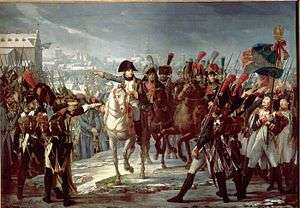II Corps (Grande Armée)
The II Corps of the Grande Armée was a French military unit that existed during the Napoleonic Wars.
| II Corps | |
|---|---|
 The II Corps at Augsburg during the Ulm campaign | |
| Active | 1805–1815 |
| Country | |
| Branch | Army |
| Type | Corps |
| Size | 2-4 infantry divisions, along with cavalry and artillery elements |
| Engagements | War of the Third Coalition Peninsular War War of the Fifth Coalition Russian campaign War of the Sixth Coalition War of the Seventh Coalition |
| Commanders | |
| Notable commanders | Jean-Baptiste Bessières Jean Lannes Auguste de Marmont Nicolas Oudinot Claude Victor-Perrin Honoré Charles Reille Jean Reynier Jean-de-Dieu Soult |
Campaigns
At its formation in 1805, General Auguste de Marmont was appointed commander of the II Corps.
Batavian Division, commanding officer Général de Division Count Jean-Baptiste Dumonceau[1]
- 1st Batavian Dragoon Regiment (2 Squadrons)
- 1st Batavian Hussar Regiment (2 Squadrons)
- 1st & 2nd Battalions, 1st Batavian Regiment
- 1st & 2nd Battalions, 2nd Batavian Regiment
- 1st & 2nd Battalions, 6th Batavian Regiment
- 1st & 2nd Battalions, Waldeck Regiment
- 1st Battalion, 1st Batavian Light Regiment
- 2nd Battalion, 2nd Batavian Light Regiment
- 1st Foot Artillery
War of the Third Coalition
The corps participated in the Ulm campaign before advancing southeast to serve as a flank guard. Still under Marmont, the troops then served as the garrison of the Illyrian Provinces until 1809 when they became the Army of Dalmatia and later XI Corps.
Peninsular War
A new II Corps was created in 1808 in northern Spain from troops under Marshal Jean-Baptiste Bessières. Soon after, Marshal Jean-de-Dieu Soult took command of the formation. In 1810, General Jean Reynier assumed command of the II Corps in Spain until 1811 when the unit was suppressed.
War of the Fifth Coalition
Meanwhile, a parallel II Corps was created in 1809 to fight against Austria. The formation was led first by Marshal Nicolas Oudinot, then by Marshal Jean Lannes who was fatally wounded at Aspern-Essling. Oudinot then took over II Corps again and won his marshal's baton at Wagram in July 1809.
Russian campaign
Still commanded by Oudinot, the corps took part in the invasion of Russia in 1812, at which point its size was roughly 40,000 men.
6th Division (Legrand)
- Joseph Jean-Baptiste Albert Brigade
- 26th Light Infantry Regiment (4 battalions)
- Moreau Brigade
- 56th Line Infantry Regiment (4 battalions)
- Nicolas Joseph Maison Brigade
- 19th Line Infantry Regiment (4 battalions)
- Pamplona Brigade
- 128th Line Infantry Regiment (2 battalions)
- 3rd Portuguese Regiment (2 battalions)
8th Division Jean-Antoine Verdier
- Raymond-Vivies Brigade
- 11th Light Infantry Regiment (4 battalions)
- 2nd Line Infantry Regiment (5 battalions)
- Pouget Brigade
- 37th Line Infantry Regiment (4 battalions)
- 124th Line Infantry Regiment (3 battalions)
9th Division (Swiss) Pierre Hugues Victoire Merle
- François Pierre Joseph Amey Brigade
- 4th Swiss Regiment (3 battalions)
- 3rd Provisional Croatian Regiment (2 battalions)
- Condras Brigade
- 1st Swiss Regiment (2 battalions)
- 2nd Swiss Regiment (3 battalions)
- Coustard Brigade
- 3rd Swiss Regiment (3 battalions)
- 123rd Line Infantry Regiment (4 battalions)
Corps Cavalry
- Bertrand Pierre Castex Brigade
- 23rd Chasseurs-à-Cheval Regiment (4 squadrons)
- 24th Chasseurs-à-Cheval Regiment (4 squadrons)
- Jean-Baptiste Juvénal Corbineau Brigade
- 7th Chasseurs-à-Cheval Regiment (4 squadrons)
- 20th Chasseurs-à-Cheval Regiment (4 squadrons)
- 8th Chevau-Légers-Lanciers (4 squadrons)
Sources: Les effectifs de la Grande-armée pour la campagne de Russe de 1812 - Paris 1913 Adjutant's Call of the Military Historical Society Vol. III - U.S.A.
War of the Sixth Coalition
The II Corps was reorganized in Germany in 1813, with Marshal Claude Victor-Perrin appointed to lead it.
War of The Seventh Coalition
The corps was headed by General Honoré Charles Reille in 1815 and took part in the Battle of Waterloo.
- George Nafziger, Batavian Division French II Corps 29 November 1805, United States Army Combined Arms Center